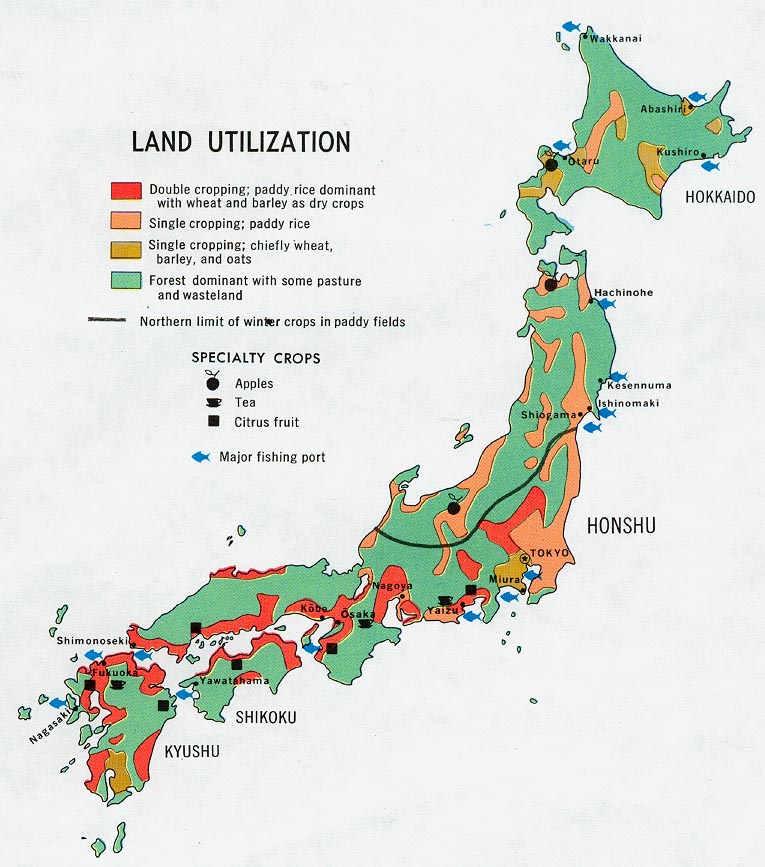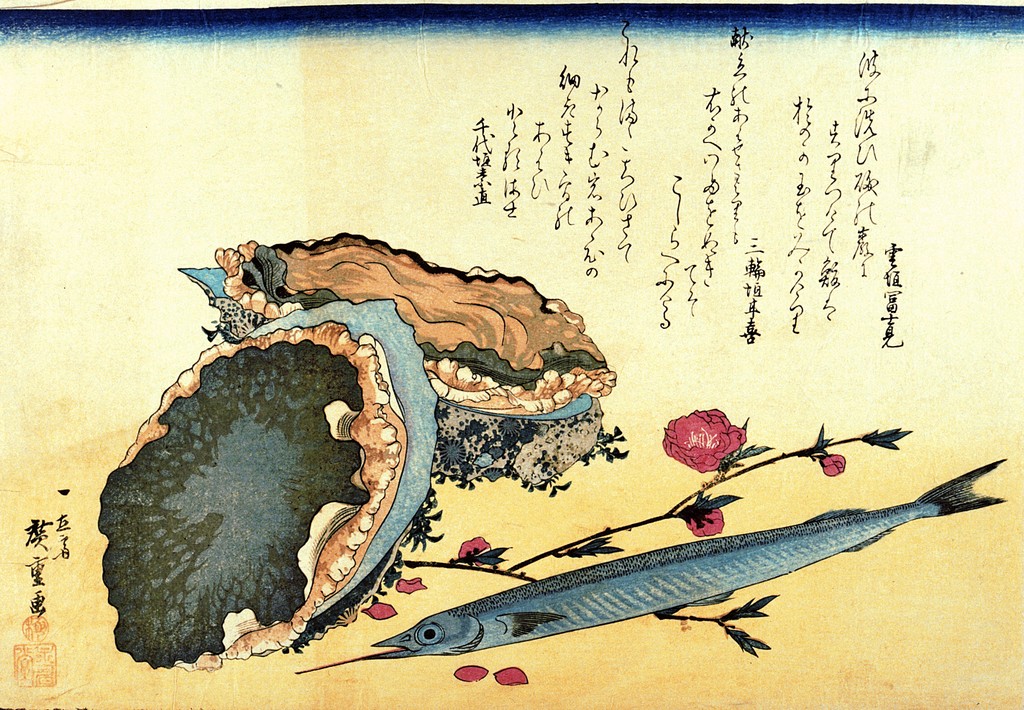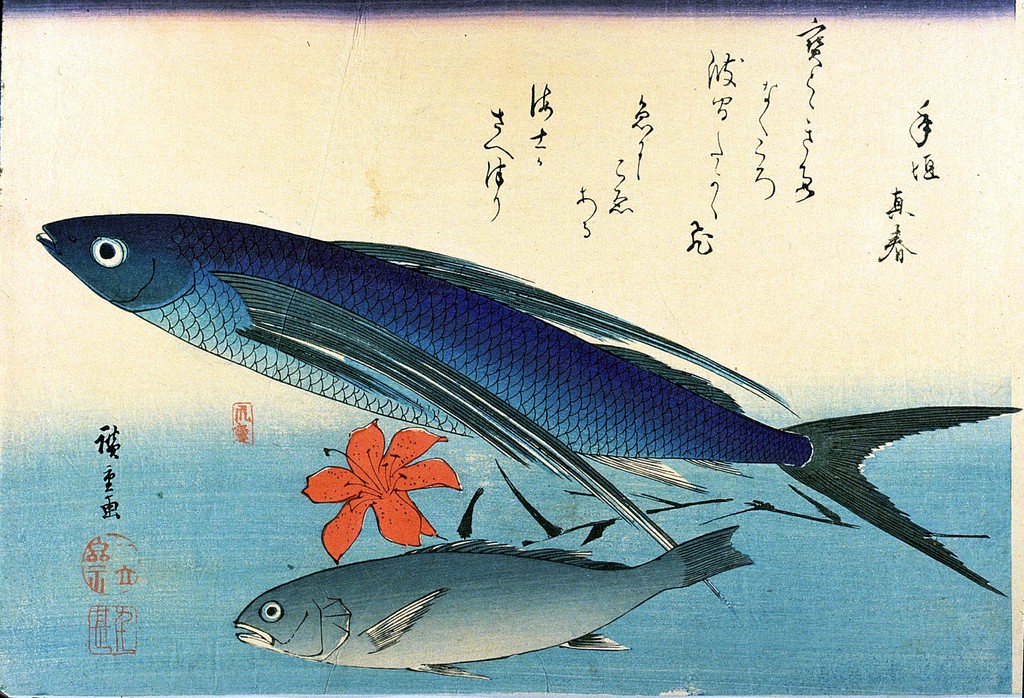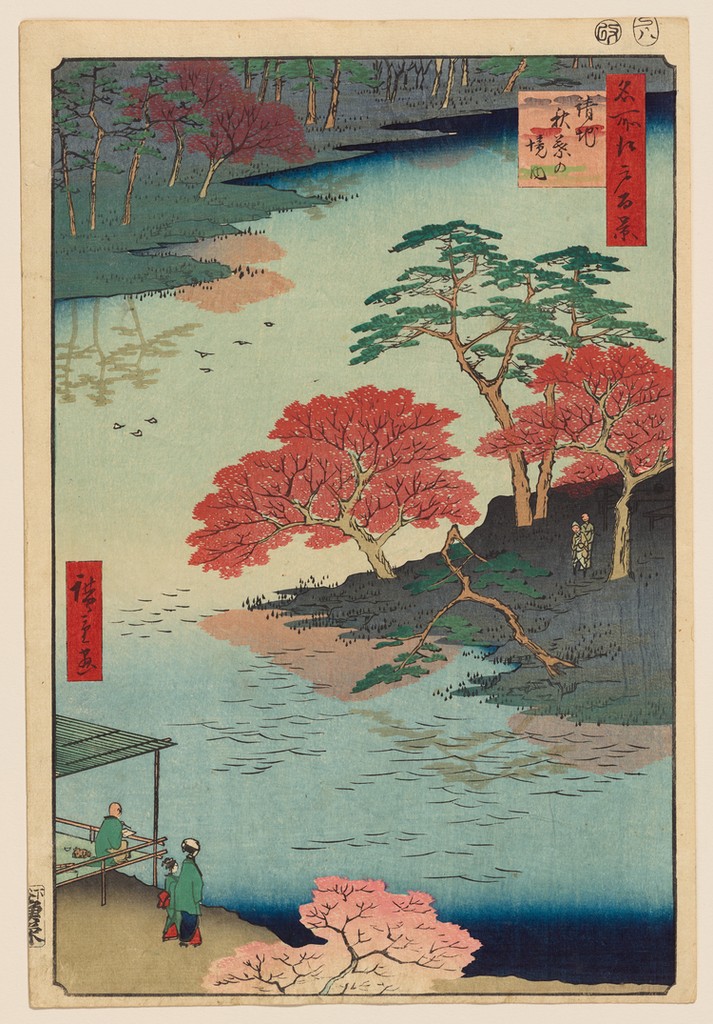Sofia Di Scipio
Overview
Water has been an essential means of life, transportation, and trade in Japan for centuries. The significance of fish as a source of sustenance commenced in 676 when Emperor Tenmu prohibited the eating and killing of mammals; thus, establishing fish as the primary form of protein for Japan. Yet, during the Edo Period (1603-1867), fish became a pertinent origin of wealth through the development of fishery businesses. The ideology of fish bringing prosperity to Japan can even be noted in the word “Katsuobushi,” or smoked fish. This is because the word “katsuo” is translated as ‘victory’ and is interpreted as fish bringing victory in the word ‘Katsuobushi’ (Johnston & Shriver, 2001).
Ando Hiroshige (1797-1858) was a master of ukiyo-e woodblock printing during Edo Period in Japan. Hiroshige began painting around the age of twelve and his early work predominantly focused on vertical narrow landscapes. In the middle of the 19th century, Hiroshige concentrated his prints on landscape design as well as various series of prints depicting Japan, and a small series of fish prints. In this exhibition, three prints are derived from Hiroshige’s “A Shoal of Fishes” series, the fourth image is a single print, and the final print is from his “One Hundred Famous Views of Edo” series. Each of these five prints either explicitly depicts fish or a body of water while also conveying the subject as a source of wealth and prosperity for Japan.
For this exhibition, I used Artstor online database to find woodblock prints. The three prints in Hiroshige’s “A Shoal of Fishes” Collection were all in the Caroline Black Collection and were able to be viewed and analyzed in person. Unfortunately, the final two images “Harbor Scene-Boats” and “Inside Akiba Shrine, Ukeji” were not available to view in person and could only be visualized digitally. The only downside to being confined to the digital version of the print is not having the ability to see finer details of the print. For instance, when viewed in person details including cross-hatching, fine brush strokes, and accurate colors were more apparent. But fortunately, the images on Artstor were high definition which did alleviate the disadvantage of not viewing them in person. Future works for this exhibition can include Hiroshige’s landscape prints during his travels around Japan that include any body of water or aquatic life.

URL: https://mapcruzin.com/free-maps-thematic/japan_land_1971.jpg

#5 Sayori & Awabi/Tokobushi (Japanese halfbeak & abalone)
Creator: Hiroshige, Ando
Culture: Japanese
Work Type: color woodcut
Date: 1840
Period: Edo (1603-1867)
Material: ink on paper
Measurements: Image 26 x 36 cm
Repository: Wetmore Print Collection, Art History Dept, Cummings Arts Center, Connecticut College, New London
Donated by Prof. Caroline Black, Botany Dept, Connecticut College
Description: This is the 5th print in Hiroshige’s series that illustrates from left two abalones, a Japanese halfbeak, what appears to be dark pink roses, a poem in the top right corner, and two seals in the bottom left corner. At the top of the piece is a deep blue horizontal border that fades into pale yellow and deepens into a darker yellow towards the bottom of the print. The colors utilized in this print are mainly earth tones with varying shades of yellow, orange/brown, and blues. The rose and the halfbeak lay parallel to each other with its mouth pointing towards the abalones. The abalones are extremely detailed you can actually see bits of seaweed and limpets on the underside of the shell. Abalones are also known to symbolize the water and its fertility which coincides with the symbolic nature of the rose which highlights nature’s fecundity. In Eastern Japan, abalones are also commonly eaten during the new year to bring hopes for prosperity and longevity to a household.

#6 Tobiuo & Isimochi (flying fish & white croaker)
Creator: Hiroshige, Ando
Culture: Japanese
Work Type: color woodcut
Date: 1840
Period: Edo (1603-1867)
Material: ink on paper
Measurements: Image: 26 x 36 cm
Repository: Wetmore Print Collection, Art History Dept, Cummings Arts Center, Connecticut College, New London
Donated by Prof. Caroline Black, Botany Dept, Connecticut College
Description: Starting from the bottom, this print depicts a white croaker, a red hibiscus flower, a flying fish as well as 3 red seals in the bottom left corner and a poem in the top right corner. You can see a gradient of blue starting from an indigo blue at the top of the piece which fades into a pale yellow and returns to a softer light blue. This lighter blue color represents the Pacific Ocean since both fish live in saltwater. Flying fish are also a major dried product in Edo Japan which emphasizes its role in the advancement of Japan’s economy as well as a source of sustenance for society. Similar to the background, the flying fish also has a gradient of Prussian blue which is an expensive material that further demonstrates the role of fish in aggrandizing Japan’s economy in the Edo Period. The red hibiscus flower adds contrast to the primarily blue print. The red flower is placed in between both fish which magnifies the fish’s natural beauty. By having multiple fish Hiroshige evokes the idea of the ocean’s fertility which reflects the economic wealth water has brought to Japan through the trade of fish.

#18 Hobo/Kangashira & Karei (gurnard, sea robin & righteye flounder)
Creator: Hiroshige, Ando
Culture: Japanese
Work Type: color woodcut
Date: 1840
Period: Edo (1603-1867)
Material: ink on paper
Measurements: Image 26 x 36 cm
Repository: Wetmore Print Collection, Art History Dept, Cummings Arts Center, Connecticut College, New London
Donated by Prof. Caroline Black, Botany Dept, Connecticut College
Description: Starting from the bottom, Hiroshige implements two blue and brown sea robins with a yellow right-eyed flounder in between them as well as kelp surrounding the three fish. A thin black line begins at the top of the piece and fades into yellow and blue with splotches of red on the left side of the background. It’s interesting that Hiroshige uses kelp in this piece since kelp was the most popular commodity in Edo Japan and it was traded heavily with China who used kelp medicinally due to its high amounts of iodine. Dried flounder was also a very traded product at this time (Johnston & Shriver, 2001). The combination of these figures highlights the duality of the sea as a source of economic prosperity and as a source of healing and nourishment for Japan.

Creator: Hiroshige, Ando
Culture: Japanese
Work Type: woodcut, print
Date: 1797-1858
Period: Edo (1603-1867)
Material: ink on paper
Measurements: 14 1/4 x 9 in. (36.2 x 22.9 cm)
Repository: Trinity College Art Collection, Trinity College (Hartford, Connecticut, USA)
Philip Kappel Collection of Japanese Woodblock Prints
Description: Seven boats are depicted in the center of this vertical print and appear to contain many fishermen with their rods cast into the sea. Hiroshige portrays the liveliness of the water through its undulating waves, the formation of white caps from the boats, and the presence of fish at the bottom of the print. Depth perception can also be visualized as the boats appear to be increasingly smaller the closer they are to the mountain near the horizon line. The print also evokes a sense of vitality through the implementation of the rising sun since the sun rises first in the East, and thus, rises over Japan before all countries. In addition, Hiroshige offers a subtle contrast of colors between the deep blues and earth tones from the fisherman in comparison to the rising orange sun and maroon border at the top of the print. By illustrating men utilizing nature for fish, Hiroshige delineates the ocean as a form of wealth and sustenance for society during the Edo Period. By implementing the four fish, Hiroshige delineates the imminent success of the fishermen in their search for the fertile cornucopia of the sea.

One Hundred Famous Views of Edo (Meisho Edo hyakkei); No. 91, autumn section
Creator: Utagawa, Hiroshige
Culture: Japanese
Date: 1857
Period: Edo (1603-1867)
Material: color woodcut print
Measurements: Sheet: 14 1/16 × 9 1/2 in. (35.7 × 24.2 cm)
Repository: Sterling and Francine Clark Art Institute
Williamstown, Mass
Gift of the Rodbell Family Collection, 2014
Description: The Akiba Shrine was constructed during the 13th century to worship the deity that protects against fire. During the Edo Period, worshippers would visit the shrine by the inner palace of Edo Castle. In this print, five visitors can be seen admiring the natural beauty of the water and changing leaf colors. Hiroshige utilizes softer hues of pinks, greens, and blues to effectively produce the ambiance of a peaceful enshrinement. Yet, the more concentrated red trees in the center of the print appropriately reflect the deity’s intent to protect from fire. The pink and green trees that surround the body of water are all reflected on the rippling waves. Additionally, the ripples between the red seal and central pink tree can also demonstrate the presence of fish. The Japanese word, uotsukirin, meaning fish-breeding forests, refers to the addition of trees near a body of water to attract fish which was first noted during the 10th century of Japan. The densely populated trees in the upper left portion of the print play a role in the attraction of fish towards the center of the print. The fertility of the trees surrounding the water can also be attributed to the use of fish-based fertilizers which allowed for the nutrients of the sea to permeate and flourish the inland areas. Hiroshige, thus, magnifies the significant role of fish in Japan since it serves as a source of replenishment for the earth, sustenance for the body, and development of the economy.
Bibliography
Images
- Hiroshige, Ando, Japanese, 1797-1858. 1840. A Shoal of Fishes series of 20, #5 Sayori & Awabi/Tokobushi (Japanese halfbeak & abalone). color woodcut. Place: Wetmore Print Collection, Art History Dept, Cummings Arts Center, Connecticut College, New London, Donated by Prof. Caroline Black, Botany Dept, Connecticut College. https://library.artstor.org/asset/CONNASIAN_106310616922.
- Hiroshige, Ando, Japanese, 1797-1858. 1840. A Shoal of Fishes series of 20, #6 Tobiuo & Ishimochi (flying fish & white croaker). color woodcut. Place: Wetmore Print Collection, Art History Dept, Cummings Arts Center, Connecticut College, New London, Donated by Prof. Caroline Black, Botany Dept, Connecticut College. https://library.artstor.org/asset/CONNASIAN_106310616924.
- Hiroshige, Ando, Japanese, 1797-1858. 1840. A Shoal of Fishes series of 20, #18 Hobo/Kangashira & Karei (gurnard, sea robbin & righteye flounder). color woodcut. Place: Wetmore Print Collection, Art History Dept, Cummings Arts Center, Connecticut College, New London, Donated by Prof. Caroline Black, Botany Dept, Connecticut College. https://library.artstor.org/asset/CONNASIAN_106310617041.
- Hiroshige, Ando (Japanese, 1797 – 1858). Harbor Scene – Boats, overall. 1797-1858. Artstor, library.artstor.org/asset/SS36412_36412_31242878
- Utagawa Hiroshige (Japanese, 1797 – 1858). Inside Akiba Shrine, Ukeji, One Hundred Famous Views of Edo (Meisho Edo hyakkei); No. 91, autumn section. 1857. Artstor, library.artstor.org/asset/24958891
Text
- Britannica, T. Editors of Encyclopaedia. “Tokugawa period.” Encyclopedia Britannica, July 15, 2021. https://www.britannica.com/event/Tokugawa-period.
- Johnston, Richard S. and Ann L. Shriver. 2001. History of Fish Marketing and Trade with Particular Reference to Japan: International Institute of Fisheries Economics and Trade. http://hdl.handle.net/1957/35421.
- Thomsen, Hans Bjarne. 2002. “The Other Hiroshige: Connoisseur of the Good Life.” Impressions (24): 48-71. http://www.jstor.org/stable/42597929.
- Wakana, Hiroshi. 2012. “History of ‘Uotsukirin’ (Fish-Breeding Forests) in Japan.” In The Dilemma of Boundaries, 145-160. Tokyo: Springer Japan.